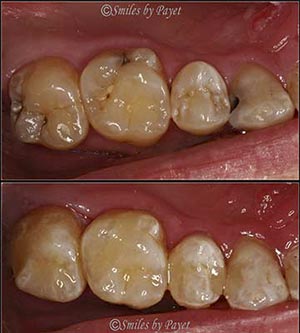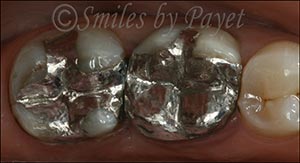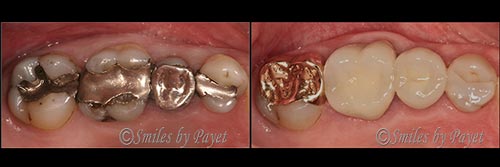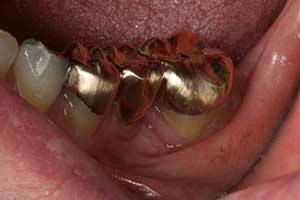Restorative Dentistry
When fixing tooth cavities and broken teeth, there are 3 basic options: Gold, Silver or White. 🙂 While most of our patients nowadays request tooth-colored restorations, we offer all 3 options.
Tooth-Colored Fillings, aka Composite Resin aka “Bonding”
Advantages of Tooth-Colored Fillings
 The most obvious advantage of tooth-colored fillings, which are made of a composite resin, is that they blend in well with your natural teeth. In fact, once they’re done, you shouldn’t even be able to tell they are there! These are the automatic choice for any fillings in teeth that show in your smile, but most of the time, we can do them for back teeth, too.
The most obvious advantage of tooth-colored fillings, which are made of a composite resin, is that they blend in well with your natural teeth. In fact, once they’re done, you shouldn’t even be able to tell they are there! These are the automatic choice for any fillings in teeth that show in your smile, but most of the time, we can do them for back teeth, too.
Besides the more natural look, however, there are 2 other important benefits of tooth-colored fillings:
- The composite fillings are bonded to the tooth, and the bonding process reinforces the tooth, to the point that it may be as strong as the tooth was before it was ever damaged by decay or trauma, and
- Because the filling is bonded in, it doesn’t need as much physical retention to hold in. This means less drilling to keep the filling in place, as is needed with silver fillings. Tooth-colored fillings are more conservative, especially since I use a dental operating microscope.
Disadvantages of Tooth-Colored Fillings
There is one disadvantage to tooth-colored dental fillings: strength. For really big fillings that cover a lot of the tooth, especially cusps (the pointy chewing parts), bonded fillings aren’t as hard or strong as silver fillings or porcelain crowns. That means they won’t last as long and need more frequent replacement. These materials keep improving though, so they can last 10-20 years.
One other small disadvantage, is that tooth-colored fillings usually do NOT work well for kids’ teeth. Baby tooth enamel is different and bonds poorly, so we recommend silver fillings for them.
Silver Fillings, aka Amalgam Fillings

First off – Dr. Oz doesn’t know SQUAT about silver fillings, so PLEASE don’t listen to him on this subject. It’s been studied to death, and plain-and-simple, silver fillings are perfectly safe. How safe? Well, both of my parents are my patients, and both of them still have silver fillings that were done decades ago, and I have ZERO intention of replacing them until absolutely necessary. If my own daughter had needed fillings on her baby teeth, I would have used silver fillings. Tooth-colored fillings don’t bond to baby tooth enamel as well, so the leak and fail faster. Now that’s out of the way…… 🙂
Four Advantages of Silver Fillings
- They’re less expensive, because they’re a bit easier to do, especially for really big ones;
- Because they’re metal, they’re very strong, so even huge silver fillings can last a long time;
- They seem to be more resistant to tooth decay for patients who seem to get cavities easily;
- They’re less technique-sensitive, so silver fillings that are only “so-so” can last a long time. Even if a little saliva contaminates them, they do fine.
Disadvantages of Silver Fillings
Well, this one’s so easy, I probably don’t need to say it, but silver fillings are kinda ugly. No two ways about it; we can polish them to a high shine that almost looks pretty, and even give them really nice shape. No matter what though, they don’t look like teeth.
The Difference Between a Filling, an Onlay, & a Crown
When a tooth is broken down, there’s a limit to how big we can make a filling. Filling materials, except for silver fillings, aren’t as tough, so they wear out much faster. When that point is reached, we start recommending either an onlay or a crown. Most people know what a crown is, but onlays are less well known, Here are the differences.
In this photo, you can see a gold onlay, 2 porcelain crowns, and a tooth-colored filling.

Just like a filling, an onlay covers just part of the tooth, but that part usually includes 1 or more cusps. This means an onlay is more conservative than a crown – it saves more healthy tooth. Since an onlay is made like a crown, either with porcelain or gold, it’s as strong and durable as a crown. This means that an onlay is stronger and longer-lasting than a filling – you won’t need the tooth worked on as often. However, it also means that an onlay costs the same as a crown, not a filling.
Porcelain or Gold for Your Onlay or Crown?
Gold is Still the “Gold Standard” for Longest-lasting

If you want the longest-lasting materials, choose gold for the longest-lasting crowns, onlays, & bridges. We don’t do many gold crowns in our office, though I try hard to talk people into them. Most people just want white teeth these days. Gold is slightly more expensive, but they last so long, they’re worth it. I’ve seen gold crowns & bridges that are literally DECADES older than I am. They look as good as they day they were put in. Gold onlays and crowns are thin yet wonderfully strong. Especially for people who grind their teeth, it’s the best!
One-Visit Porcelain Onlays & Crowns with CEREC
Since most people want their teeth to look like teeth, we make most onlays and crowns with Emax porcelain right in our office with CEREC AC Bluecam system. Emax is natural-looking & quite strong once bonded to your tooth. CEREC crowns last a very long time. It’s the same porcelain that most labs use. You get it done in 1 visit with us though, instead of multiple visits somewhere else.
If you need something even stronger than Emax, we use Zirconia. It’s almost 3 times stronger than Emax, even when 1/2 as thick. It’s still not as good as gold crowns, onlays, or bridges, but it does look like a tooth.
To make an appointment for a Complimentary Consultation:
Request an Appointment Online or call us at 704-364-7069.
We’ll look forward to meeting you soon!






